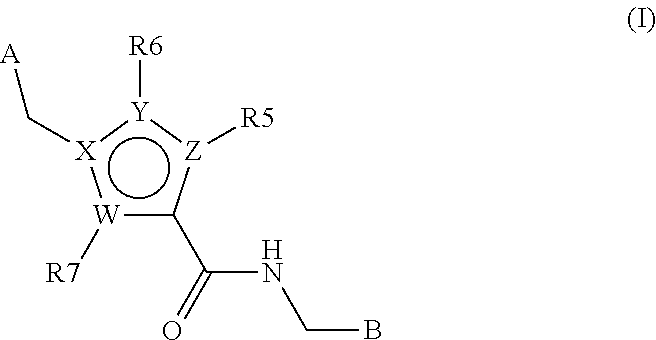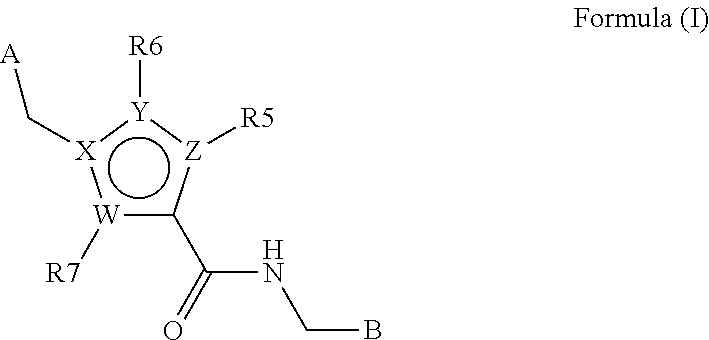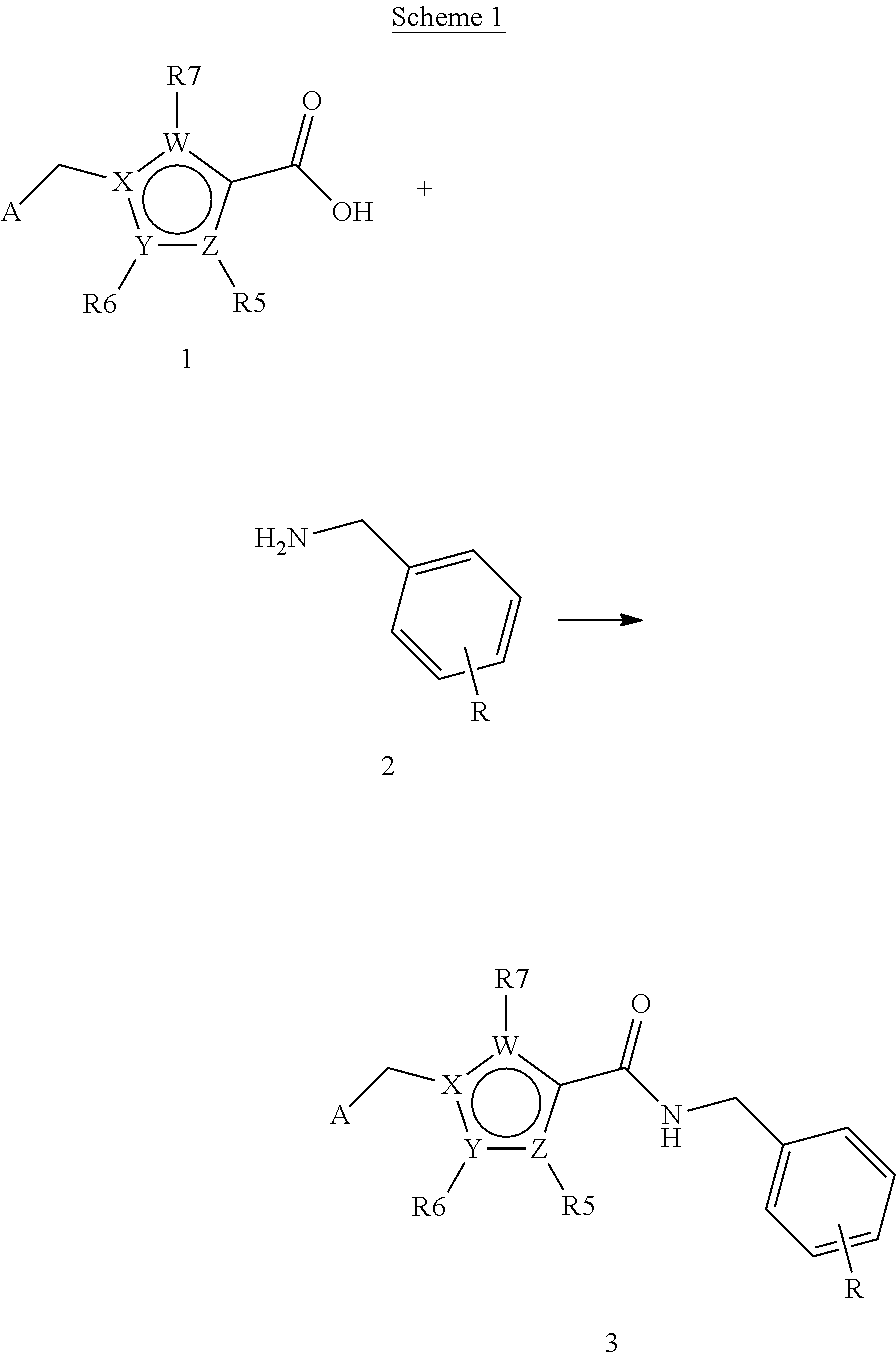Pyrazole derivatives as plasma kallikrein inhibitors
a plasma kallikrein inhibitor and pyrazole technology, applied in the field of pyrazole derivatives as plasma kallikrein inhibitors, can solve the problems of limited clinical application, no small molecule synthetic plasma kallikrein inhibitor has been approved for medical use, and abnormal abundance of plasma kallikrein-kinin system
- Summary
- Abstract
- Description
- Claims
- Application Information
AI Technical Summary
Benefits of technology
Problems solved by technology
Method used
Image
Examples
reference example b
3-Amino-1-[4-(2-oxo-2H-pyridin-1-ylmethyl)-benzyl]-1H-pyrazole-4-carboxylic acid 2-fluoro-3-methoxy-benzylamide
[0543]
[0544]3-Amino-1-[4-(2-oxo-2H-pyridin-1-ylmethyl)-benzyl]-1H-pyrazole-4-carboxylic acid (75 mg, 0.23 mmol) was dissolved in DCM (20 mL) and DMF (1 ml). This solution was cooled to 0° C. 2-Fluoro-3-methoxy-benzylamine hydrochloride (53 mg, 0.28 mmol) was added followed by HOBt (34 mg, 0.25 mmol) and triethylamine (70 mg, 0.69 mmol). Water soluble carbodiimide (53 mg, 0.28 mmol) was then added. The reaction mixture was stirred, allowed to warm to rt and stirred for 3 days. The mixture was diluted with chloroform (200 mL) and washed with NaHCO3 (aq) (50 mL), water (50 mL) and brine (50 mL), dried (Na2SO4) and evaporated in vacuo. The residue was purified by flash chromatography (silica), eluent 4% MeOH / 96% CHCl3, to give a white solid identified as 3-amino-1-[4-(2-oxo-2H-pyridin-1-ylmethyl)-benzyl]-1H-pyrazole-4-carboxylic acid 2-fluoro-3-methoxy-benzylamide (92 mg, 0.20 ...
reference example c
1-(7-Chloro-quinolin-3-ylmethyl)-3-methoxymethyl-1H-pyrazole-4-carboxylic acid 2-fluoro-3-methoxy-benzylamide
[0547]
(7-Chloro-quinolin-3-yl)-methanol
[0548]7-Chloroquinoline-3-carboxylic acid (500 mg, 2.4 mmol) was dissolved in anhydrous THF (20 mL) and cooled to −20° C. To this solution was added triethylamine (1.0 mL, 7.23 mmol) and isobutyl chloroformate (0.38 mL, 2.9 mmol). The reaction mixture was stirred at −20° C. for 20 min and then poured into a solution of sodium borohydride (731 mg, 19 mmol) in water (2 mL) at 0° C. The reaction mixture was allowed to warm to rt and stirred for 18 hours. The mixture was diluted with EtOAc (50 mL) and the layers separated. The organic layer was washed with water (20 mL), brine (20 mL), dried (Na2SO4), filtered and evaporated in vacuo to give a yellow solid. The solid was purified by chromatography on silica, eluting with EtOAc / Pet Ether to afford (7-chloro-quinolin-3-yl)-methanol as an off white solid, 134 mg, 29% yield.
[0549][MH]+=194.1
3-Br...
reference example d
3-Fluoro-4-methoxy-pyridine-2-carbonitrile
[0559]To a large microwave vial, cyanocopper (1.304 g, 14.56 mmol) was added to a solution of 2-bromo-3-fluoro-4-methoxypyridine (1 g, 4.85 mmol) in DMF (5 mL). The reaction vial was sealed and heated to 100° C. for 16 hrs. The reaction mixture was diluted with water (20 mL) and EtOAc (20 mL). The thick suspension was sonicated and required additional water (40 mL) and EtOAc (2×50 mL) with sonication to break-up the solid precipitated. The combined layers were filtered through a plug of celite and the organic layer isolated, washed with brine (50 mL), dried over magnesium sulfate, filtered and the solvent removed under reduced pressure to give a pale green solid identified as the desired compound 3-fluoro-4-methoxy-pyridine-2-carbonitrile (100 mg, 0.578 mmol, 12% yield)
(3-Fluoro-4-methoxy-pyridin-2-ylmethyl)-carbamic acid tert-butyl ester
[0560]3-Fluoro-4-methoxy-pyridine-2-carbonitrile (100 mg, 0.578 mmol) was dissolved in anhydrous methanol...
PUM
| Property | Measurement | Unit |
|---|---|---|
| weight | aaaaa | aaaaa |
| flow rate | aaaaa | aaaaa |
| flow rates | aaaaa | aaaaa |
Abstract
Description
Claims
Application Information
 Login to View More
Login to View More - R&D
- Intellectual Property
- Life Sciences
- Materials
- Tech Scout
- Unparalleled Data Quality
- Higher Quality Content
- 60% Fewer Hallucinations
Browse by: Latest US Patents, China's latest patents, Technical Efficacy Thesaurus, Application Domain, Technology Topic, Popular Technical Reports.
© 2025 PatSnap. All rights reserved.Legal|Privacy policy|Modern Slavery Act Transparency Statement|Sitemap|About US| Contact US: help@patsnap.com



